Nevada II (Battleship No. 36)
1916–1948
Nevada, the 36th state, was admitted to the Union on 31 October 1864.
II
(Battleship No. 36: displacement 27,500; length 583'; beam 85'3"; draft 28'6"; speed 20.5 knots; complement 864; armament 10 14-inch, 21 5-inch, 4 21-inch torpedo tubes; class Nevada)
The second Nevada (Battleship No. 36) was laid down on 4 November 1912 at Quincy, Mass., by the Fore River Shipbuilding Co.; launched on 11 July 1914; sponsored by Miss Eleanor Anne Seibert, niece of Governor Tasker L. Oddie of Nevada and descendant of former Secretary of the Navy Benjamin Stoddert; and commissioned on 11 March 1916, Capt. William S. Sims in command.
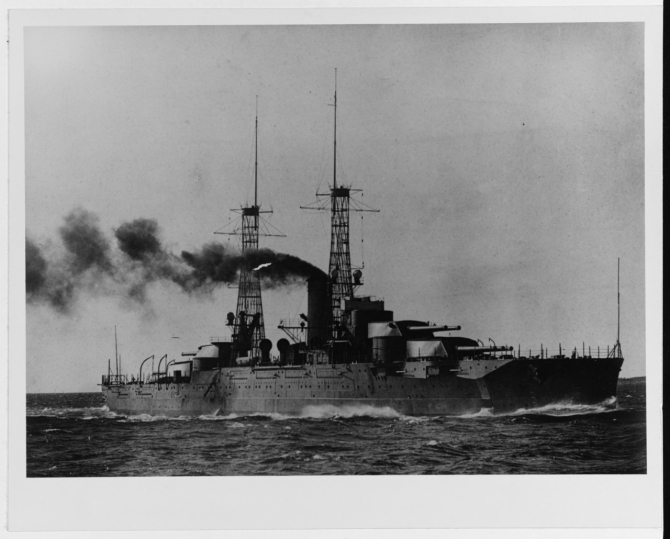
Nevada running trials, circa early 1916. (Naval History and Heritage Command Photograph NH 45796)
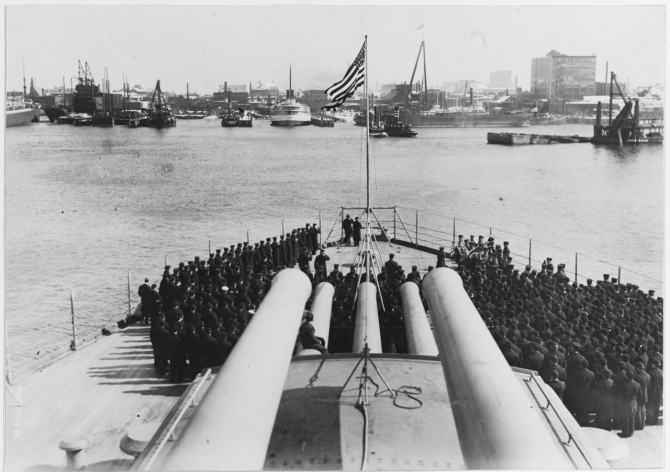
Commissioning ceremony for Nevada at the Boston Navy Yard, 11 March 1916. (Naval History and Heritage Command Photograph NH 45458)
Nevada joined the Atlantic Fleet at Newport, R.I., on 26 May 1916 and served along the East Coast. She operated with the fleet conducting gunnery training and maneuvers off Cuba (January–March 1917). With the U.S. declaration of war against Germany on 6 April 1917, Nevada was at the Norfolk Navy Yard, Portsmouth, Va., undergoing repairs. She refueled on 20 April with orders to get underway the next day. Requiring additional repairs after equipment tests, Nevada finally got underway on the 24th and anchored with the fleet in Hampton Roads, Virginia.
Initially, she was part of the Battleship Division Eight (BatDiv8), later a unit in the Battleship Force, and trained gunners in the Chesapeake Bay based from Norfolk. Nevada got underway and cleared Cape Henry, Va., with the Battleship Force on 13 August, bound for Long Island Sound. The force anchored off Base Ten at Port Jefferson, N.Y., on the 19th and operated from that location conducting tactical and gunnery training until 1 October, when the unit departed for a return to Norfolk. Conducting tactical maneuvers and training en route, the Battleship Force returned to Hampton Roads on 6 October. That same day two officers from the Russian Navy, Lt. Cmdr. B. Besoir and Lt. I. Vouiton, having embarked on 30 September, disembarked. The next day, Secretary of the Navy Josephus Daniels, on board the converted yacht Mayflower, stood up the river and anchored near Pennsylvania (Battleship No. 38). On 25 October, after several days of rehearsals, Nevada got underway and conducted Short-Range Battle Practice and returned to Lynnhaven Roads, Virginia.
Through November and into December 1917, based at Norfolk, Nevada continued to train her crew in preparation for deployment for combat action. Adm. William S. Benson, Chief of Naval Operations (CNO), on 7 December 1917, ordered the removal of two five-inch guns, mounts, accessories, and spare parts from Nevada along with the battleships Pennsylvania, Arizona (Battleship No. 39), Texas (Battleship No. 35), Oklahoma (Battleship No. 37), Arkansas (Battleship No. 33), Kearsarge (Battleship No. 5), and Kentucky (Battleship No. 6). The crew enjoyed liberty through the holiday season on a rotating basis.
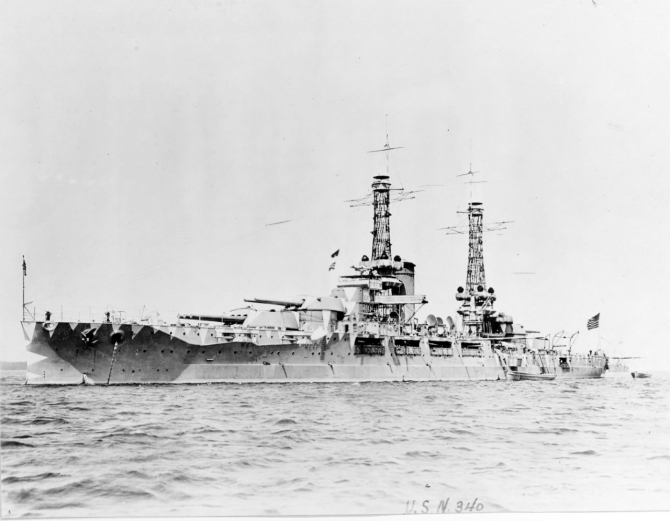
Nevada photographed circa 1917, painted with rangefinder-confusing camouflage. (Naval History and Heritage Command Photograph NH 45439)
With the onset of 1918, Nevada continued the program of tactical maneuvers and gunnery training through the first half of the year. Adm. Benson, on 30 July 1918, wrote Vice Adm. Sims that the Navy Department was of the opinion that a raid by a German battle cruiser against supply lines, particularly troop convoys, was a possibility and that even the potential chance of a raid should be guarded against. Benson specified plans to station Battleship Division 6 (BatDiv6) Utah (Battleship No. 31), Nevada, and Oklahoma, at Queenstown or Brest, and hold Battleship Division Five (BatDiv5), Arizona, Mississippi (Battleship No. 41), New Mexico (Battleship No. 40), and Pennsylvania, to cover the western Atlantic or proceed where necessary. The Navy Department also asked the State Department to request the Japanese government to detail a division of battlecruisers to join the Atlantic Fleet at Hampton Roads and conduct search operations.
Nevada and Oklahoma, under Rear Adm. Thomas S. Rodgers, sailed from Hampton Roads on 12 August 1918, arriving at Bantry Bay, Ireland, on 23 August. Stationed at Berehaven, Ireland, and designated the Bantry Bay Squadron, this force was intended to counter the threat of a German high-speed raider breaking out into the Atlantic to attack U.S. troop transports and other convoys in the Western Approaches. Utah joined the battleships off Ireland on 10 September. Nevada was to participate in gunnery practices and tactical drills later in September, but she missed the exercises when the accompanying minesweepers were withdrawn prematurely in order to return to Queenstown [Cobh], Ireland.
The Admiralty and the Navy Department agreed to a plan on 10 October 1918 to protect troop convoys when it was reported that German battlecruisers had escaped into the Atlantic. With two troop convoys en route to France, Rear Adm. Rodgers ordered the division, with a screen of seven destroyers, to rendezvous with the convoys. The battleships and escorting destroyers made contact with both inbound convoys, respectively, and in each instance escorted them into the danger zone. Once through, the battleships detached from each and allowed the destroyers to escort them into port. Despite reports to the contrary, the German ships never sortied and the transports were never in danger from surface raiders.
Spanish influenza struck Berehaven at the end of October 1918 and during the week of the 26th, seven members of Nevada’s crew died (along with four each from Oklahoma and Utah). A hospital was established and a strict quarantine enforced. By 10 November, Rear Adm. Rodgers reported that there were few cases of influenza in his force, though two additional sailors from Nevada died that week. During the outbreak, drills were limited to frequent fire control and fire distribution drills conducted at anchor.
The Armistice ending hostilities went into effect on 11 November 1918. Afterward, on 18 November, Nevada steamed for Rosyth, Scotland, escorted by the destroyers Stockton (Destroyer No. 73), McCall (Destroyer No. 28), Davis (Destroyer No. 65), and Trippe (Destroyer No. 33) to join the U.S. battleships, Battleship Division Nine (BatDiv9), operating with the British Grand Fleet as Battle Squadron Six. She, however, arrived too late to witness the surrender of the German High Seas Fleet on 21 November.
Nevada then shifted to Portsmouth, England, to rejoin BatDiv6. Later, they were joined by the other U.S. battleships in European waters and, on 11 December 1918, Vice Adm. William S. Sims, Commander of U.S. Naval Forces in European Waters, arrived and assumed command. The ships refueled and prepared to serve as President Woodrow Wilson’s escort to Brest, France. Standing out of Portsmouth that same day, the battleships rendezvoused on 13 December with the transport George Washington (Id. No. 3018), with President Wilson embarked, and her escort, the flagship of the U.S. Atlantic Fleet, Pennsylvania. Each ship of the force rendered a 21-gun salute for the President as the transport passed their beam. On 14 December, with their escort mission completed, the battleships stood out of Brest, bound for the U.S.
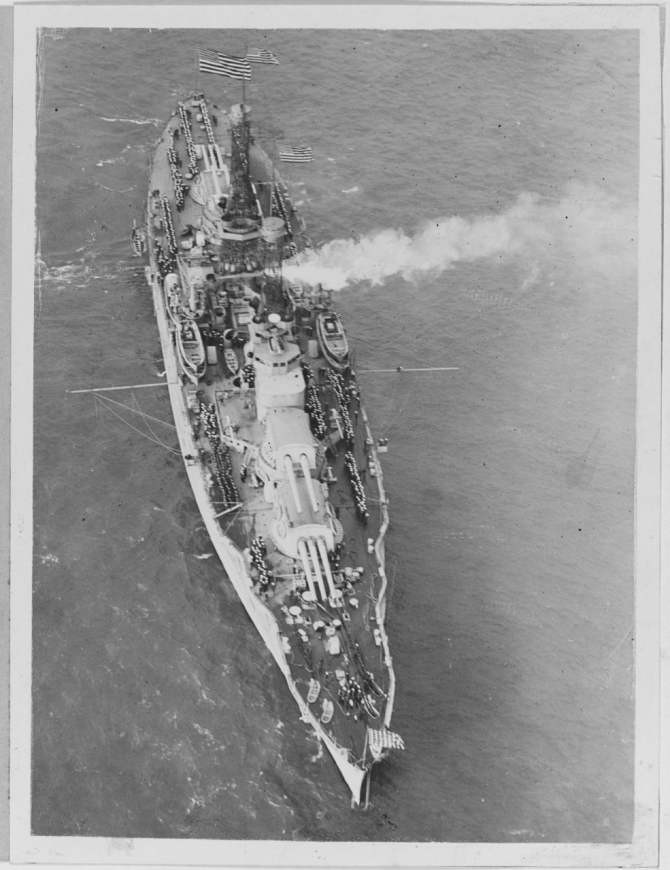
Nevada convoying President Woodrow Wilson off Brest, France, in December 1918. (Naval History and Heritage Command Photograph NH 48142)
While en route home on 20 December 1918, the battleships encountered heavy seas and rolled heavily. On 26 December, they entered New York harbor and passed the converted yacht Mayflower anchored off the Statue of Liberty with Secretary of the Navy Josephus Daniels embarked; each fired a 19-gun salute; and anchored in the North River. Battalions from the various ships formed and paraded through the streets of New York celebrating the end of hostilities.
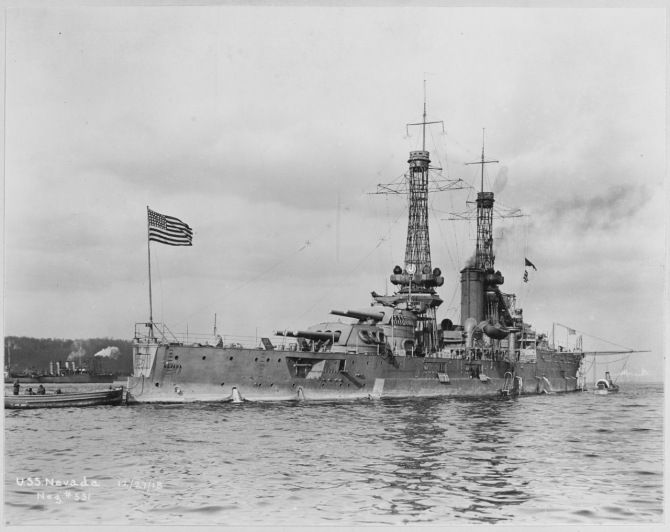
Nevada off New York City, 27 December 1918. (Naval History and Heritage Command Photograph NH 60666)
With increased tensions between the U.S. and Japan in 1919, President Wilson transferred a number of warships to the Pacific. As part of that redeployment, Nevada transited the Panama Canal, arriving at San Pedro., Calif., on 9 August. The battleship then cruised with other U.S. ships making port visits along the Pacific coast, at Santa Barbara, Calif.; San Francisco, Calif.; Bremerton, Wash.; and Seattle, Wash.
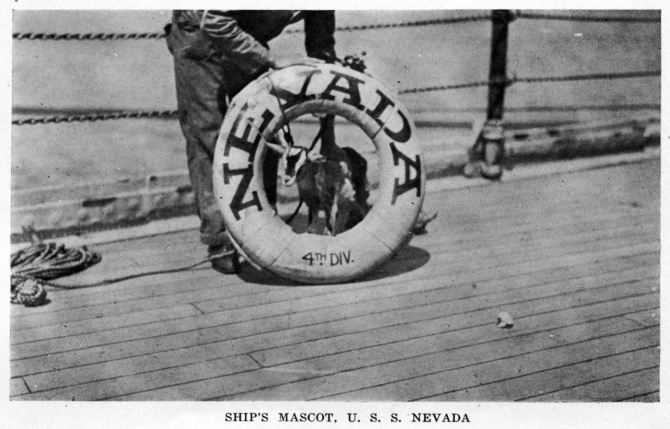
Halftone reproduction of a photograph of the ship's mascot goat, posed in a life ring. It was published circa 1919 as one of ten images in a souvenir folder concerning Nevada. Donation of Dr. Mark Kulikowski, 2007. (Naval History and Heritage Command Photograph NH 104609)
Afterward, Nevada returned to the East Coast and re-joined the Atlantic Fleet as a constituent of Battleship Division Seven (BatDiv7). She was re-designated BB-36 on 17 July 1920.
With Arizona (BB-39), flagship, Nevada, Oklahoma, Pennsylvania, Utah, Delaware (BB-28), and North Dakota (BB-29), BatDiv7 arrived at Guantanamo Bay, Cuba, for winter training on 9 January 1921. The division then moved on to Colon, Canal Zone (C.Z.) and, after transiting the Panama Canal, rendezvoused with the Pacific Fleet under Adm. Hugh Rodman to conduct a night battle practice off Panama. The combined fleets headed south and after crossing the equator, the ships of the Atlantic Fleet visited Callao, Peru. Arriving on 31 January, the fleet remained for a week and then departed to rejoin the Pacific Fleet for athletic competitions in Panama. Nevada’s race-cutter team defeated that of Arizona for the prestigious Battenberg Cup. Afterward, the fleets separated and each returned to their respective drill grounds for additional gunnery practice.
During the summer of 1921, Arizona, Nevada, and Oklahoma returned to Callao (22 July–3 August) to celebrate the Peruvian Centennial Exposition. Nevada then departed for a return to the U.S. With stops at Balboa, C.Z. (8–11 August), San Diego, Calif. (22–24 August), and San Francisco, Calif. (26 August–6 September) en route, Nevada finally arrived at the battleship anchorage at San Pedro on 8 September. She remained in port until 18 November, when she got underway for a visit to San Francisco from 20 November through 2 December. Returning to San Pedro on 3 December, the battleship stood at anchor in her homeport into January 1922.
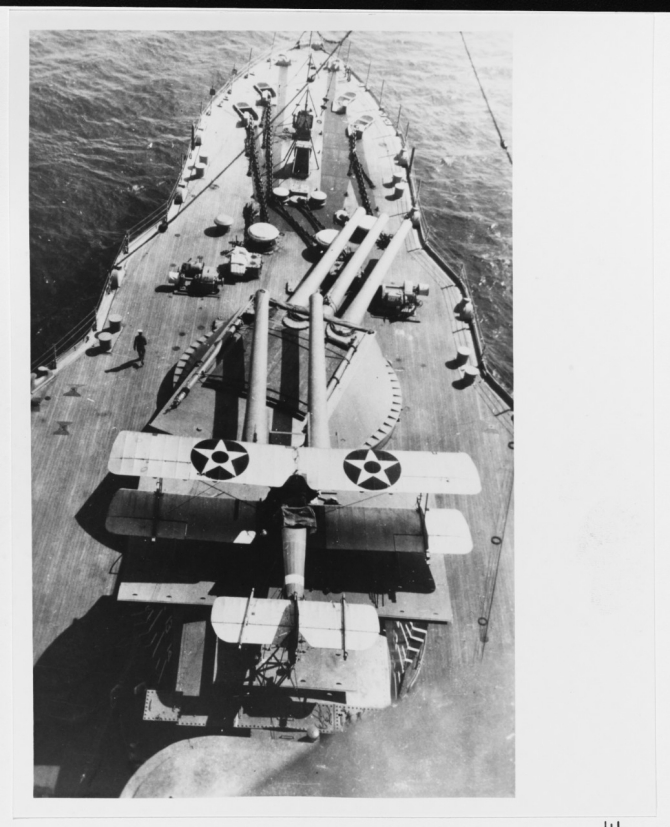
A view looking forward from the foremast showing a Sopwith One-and a Half Strutter on the aircraft platform atop Turret II, circa 1921. Collection of Delmar Ketch. (Naval History and Heritage Command Photograph NH 93422)
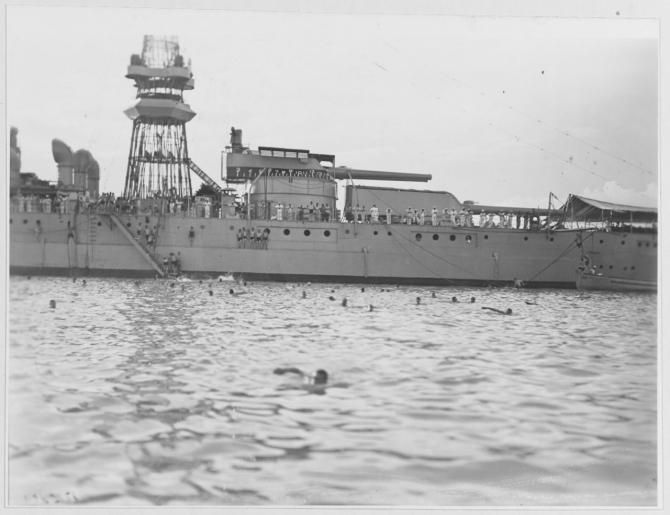
Swimming off Nevada, 1921. (Naval History and Heritage Command Photograph NH 122979)
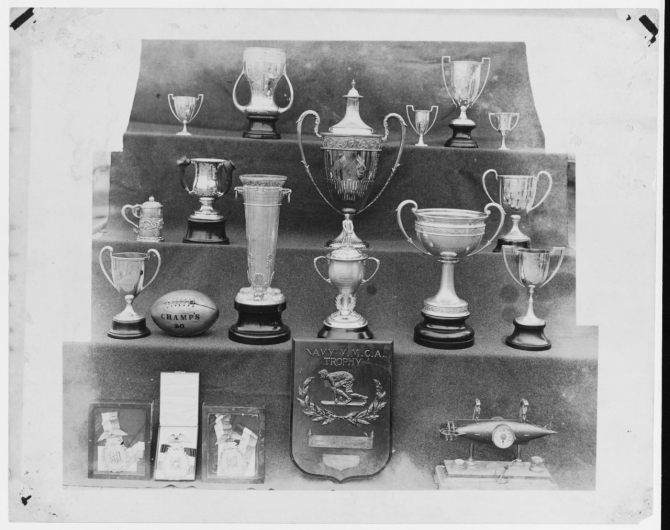
Nevada’s athletic trophies won by the ship's crew photographed circa 1921. Collection of Delmar Ketch. (Naval History and Heritage Command Photograph NH 93412)
Nevada got underway on 19 January 1922 bound for San Francisco. Reaching her destination two days later, she stayed until 15 February, when she departed for San Pedro and arrived there on the 17th. The battleship remained at San Pedro until 6 May, when she weighed anchor for a return to the East Coast. En route to Norfolk, she visited San Diego (6–8 May) and Balboa (19–24 May), and after passing through the Panama Canal, arrived at the Norfolk Navy Yard on 31 May. She underwent maintenance until 15 August and then spent several days at anchor in Hampton Roads, Va. On 18 August 1922, Nevada and Maryland (BB-46) left for a goodwill tour representing the United States for the centennial of Brazilian independence. The ships visited Rio de Janeiro (6 September–10 October and 18 October–16 November) and Santos (11–16 October), before returning to Hampton Roads on 9 December. Nevada then shifted to Dahlgren, Va., and spent time on the Potomac River (11–18 December) before returning to Hampton Roads and another stay at the Norfolk Navy Yard from 19 December 1922 through 13 January 1923.
While Nevada was en route back to the U.S. on 6 December, a general order reorganized the assets of the Navy, creating the United States Fleet. The two primary subordinate commands were the Battle Fleet, based in the Pacific and encompassing most of the battleships, including all of the more modern ones, and the Scouting Fleet, based in the Atlantic and consisting of older battleships and other units. There was also the Control Force, based in the Atlantic, consisting of light forces assigned to protection of trade routes and defense against amphibious attack, and the Fleet Base Force. Remaining independent of the United States Fleet, were the Asiatic Fleet; Naval Forces, Europe; the Special Service Squadron in the Caribbean; and the submarine force.
Nevada stood out of Norfolk on 13 January 1923, for a return to the Pacific. After a time at Guantanamo for the conduct of gunnery exercises and tactical training (17 January–12 February), Nevada shifted to Culebra Island (21–23 February) en route to the Canal Zone. After transiting the Panama Canal on 23 February, the battleship stood at Balboa (23 February–31 March) before arriving at San Pedro on 11 April. She remained in port until 28 May, when she shifted to Venice, Calif. for a three-day port visit before returning home on the 31st. Nevada spent most of the latter half of the year underway and visiting cities in Washington including Port Angeles, Tacoma, and Seattle. The ship also underwent a maintenance period at the Puget Sound Navy Yard, Bremerton, Wash., from 9 October to 1 December. Nevada returned to San Pedro, via San Francisco (3–4 December), on 6 December and spent Christmas and New Year’s Day 1924 in port.
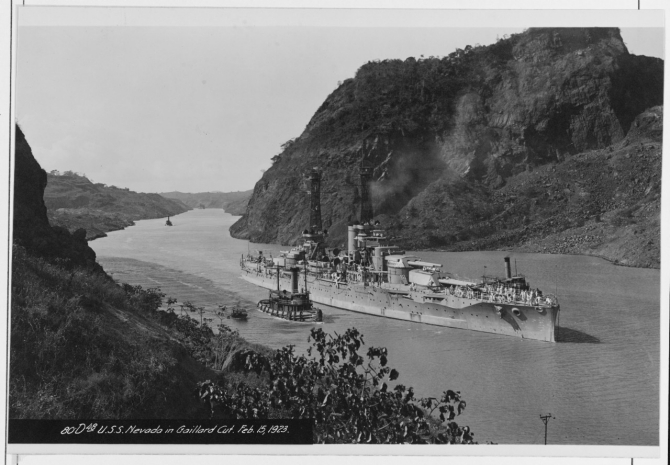
Nevada transiting the Panama Canal, 15 February 1923. (Naval History and Heritage Command Photograph NH 73829)
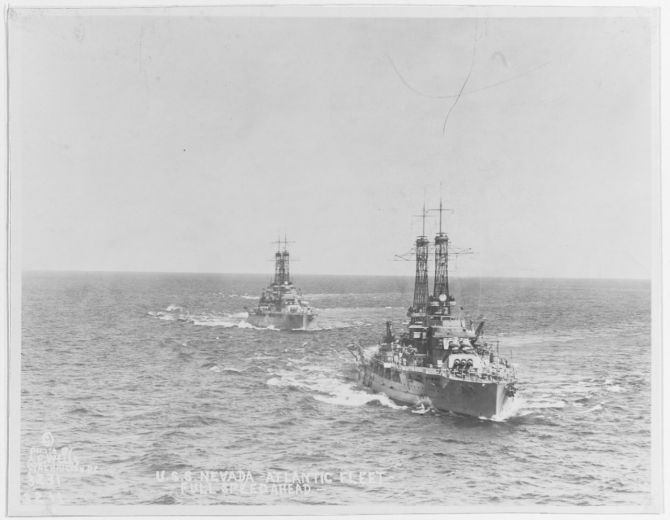
Nevada steaming in company with Oklahoma (BB-37) in the Atlantic, circa the early-mid 1920s. Photo by A.E. Wells, Washington, D.C. (Naval History and Heritage Command Photograph NH 45456)
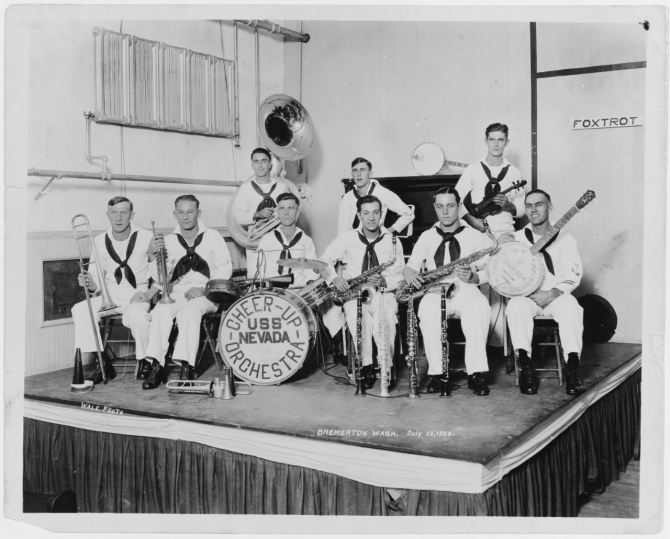
Nevada's orchestra, photographed at Bremerton, Wash., 29 July 1924, by Wale. Collection of Delmar Ketch. (Naval History and Heritage Command Photograph NH 93413)
With the New Year, however, Nevada got underway in short order. Weighing anchor on 2 January 1924, she was bound for Balboa and a return to operating in the Caribbean and Atlantic Ocean. Arriving at Balboa on 16 January, she transited the Panama Canal and departed from Colon, C.Z. on the 25th. Reaching Culebra on 1 February, Nevada stayed until she went to sea on 11 February and returned on the 15th. She got underway again on 25 February bound for New York, anchoring in the North River on 3 March. After a 10-day visit, she departed on 18 March and returned to Culebra on the 31st. Nevada stood out of Culebra on 5 April, bound for Colon she reached the same day. The next day she passed through the Panama Canal to Balboa and after remaining there until 12 April, she arrived back at San Pedro on 22 April. The battleship stood at her homeport until 21 June, when she departed bound for Bremerton. Arriving on 25 June, she went into the Puget Sound Navy Yard for repairs into August. After her maintenance availability, she made her way back south to San Pedro conducting port visits at Port Angeles, Tacoma, Seattle, and San Francisco en route. She returned to San Pedro on 8 September and through most of the balance of the year made occasional sorties from her homeport for training. She departed San Pedro on 2 December for a return to the Puget Sound Navy Yard. Entering the yard on 8 December, she underwent overhaul until 2 February 1925, when she sailed for San Pedro.
Nevada returned to her homeport on 8 February 1925 and, much as she did in the latter half of 1924, she sortied periodically from San Pedro for training and brief visits to ports in California into April. Nevada departed with the fleet from San Francisco on 15 April 1925, for war games in the Hawaiian area which concluded on 29 May. Afterward, the fleet prepared for a goodwill tour “Down Under.” Nevada, in company with 10 battleships, 4 light cruisers, 32 destroyers, and 13 auxiliaries, departed Honolulu (T.H.), on 1 July bound for Australia and New Zealand.
While underway, the fleet engaged in tactical maneuvers and called at Pago Pago, Samoa (9–11 July), to refuel before reaching Melbourne, Australia, on 22 July. After an eventful and successful stay in Australia, Nevada got underway on 6 August for New Zealand, reaching Wellington on 11 August. The fleet then departed on 24 August for a return to the U.S. via Samoa and Pearl Harbor. After meeting with Assistant Secretary of the Navy T. Douglas Robinson, embarked in Arizona, the ships of the Battle Fleet passed in review and anchored at San Pedro on 26 September. She then spent the months into December, making periodic sorties for training. Returning to San Pedro on 19 December, she remained in port through the end of the year.
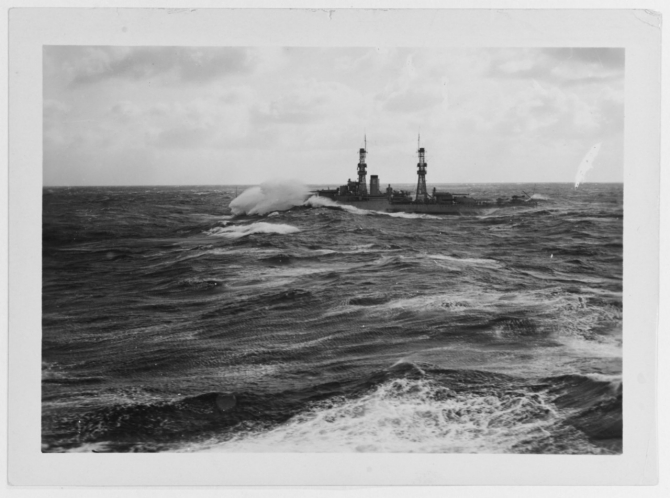
Nevada underway in 1925. "No we're not sinking, we'll come up again. This is a moderately heavy sea." Courtesy of Captain F. Kent Loomis, USN (Ret.), Assistant Director of Naval History. (Naval History and Heritage Command Photograph NH 63646)
As she did two years previously, Nevada got underway just after New Year’s Day. On 2 January 1926, she weighed anchor bound for Bremerton. Arriving on the 6th, she remained at the Puget Sound Navy Yard until 19 February. Departing the yard, she returned to San Pedro via San Francisco on 23 February, in advance of a departure for Balboa, two days later. Reaching Panama on 8 March, she departed on the 13th en route to Port Culebra, Costa Rica. Arriving on 15 March, she departed on 20 March and returned to San Pedro on 1 April. Having visited Washington State in July and August, Nevada largely operated from San Pedro through the end of the year. Corroded condensers temporarily prevented Nevada from operating with the Battle Fleet, causing the crews of the other battleships to refer to her derisively as the “Pond Lily.” During that time, however, the ship’s rowing team again scored a victory in the fleet cutter races, defeating the team from Mississippi and reclaiming the Battenberg Cup. The ship, after a one-day sortie, returned to San Pedro on 11 December and remained in port through the end of 1926.
Still at anchor on New Year’s Day, Nevada got underway on 15 January 1927 and returned to port the same day. After another short sortie on 17–18 January, she got underway on 10 February bound for San Francisco. Reaching on the 11th, she entered the yard at Hunter’s Point that same day and underwent repairs through 15 February. She arrived back at San Pedro the next day. She then weighed anchor on 18 February bound for Balboa. Arriving on 6 March, she remained three days and transited the Panama Canal to Cristobal, C.Z. on the 6th. Departing on 9 March, Nevada steamed to Gonaïves, Haiti, where she arrived on 14 March. After two-weeks in the Haitian port, she weighed anchor on 28 March and reached Guantanamo on 2 April. Having conducted training in Cuba until 18 April, she put to sea. Returning to Gonaïves for a brief visit on the 22nd, she subsequently charted a course for the Norfolk Navy Yard. Passing the Virginia capes on 28 April, Nevada entered the yard and underwent repairs until 28 May. The next day she made a one-day voyage up the Chesapeake Bay to the U.S. Naval Academy at Annapolis, Md., and returned to Hampton Roads on 3 June. The next day, she made the outward passage past Capes Charles and Henry bound for Colon. After a week-long passage, she reached Colon on 11 June. Passing through the Panama Canal on 15 June, she continued on to San Diego directly, arriving on the 27th. Leaving San Diego on 1 July, Nevada went to San Francisco (3–12 July) before returning to her homeport on the 14th. Just four days later, she got underway again to return to the East Coast. Reaching Balboa on 30 July, she transited the Panama Canal on 2 August and steamed directly to Guantanamo. Arriving on 5 August, she shuttled between there and Gonaïves twice before getting underway for Annapolis. Arriving on 25 August, she remained until 9 September, when she shifted to Baltimore, Md. for a port visit. On 13 September, Nevada stood down the Chesapeake Bay bound for Hampton Roads. The next day, she entered the Norfolk Navy Yard and on 16 September and was placed in reduced commission pursuant to her modernization.
At a cost of $7 million, two tripod masts replaced the lattice cage masts; anti-torpedo blisters were added, broadening the ship’s beam; antiaircraft guns were added and the torpedo equipment was removed. Additionally, the funnel was moved slightly aft and a deckhouse installed. The change of the hull design with the addition of the blisters reduced the ship’s speed and made her unwieldy at slow speeds. Despite this modification, Nevada continued to be one of the best performing battleships in gunnery in the U.S. Fleet.
After her modernization was completed in January 1930, Nevada was returned to full commission, Capt. Hilary H. Royall in command, and departed Norfolk bound for Guantanamo as a unit of Battleship Division Three (BatDiv3). From Cuba, she conducted battle practice off Panama and then steamed to New York. Nevada later participated in a Presidential Review for President Herbert Hoover off Hampton Roads on 7 May 1930. Afterward, she transited the Panama Canal and returned to the Pacific and her homeport at San Pedro. Nevada made a summer cruise to the Pacific Northwest calling at Piner Point, Wash., Tacoma, Port Angeles, Bremerton, and Seattle. Departing Seattle for home on 16 August, via San Francisco, Nevada anchored at San Pedro on 26 August. With the exception of a short sortie to and return from San Francisco (8–14 November), Nevada remained in port from 26 August 1930 through 5 February 1931.
Nevada weighed anchor, on 5 February 1931, and got underway bound for Panama. Arriving on 22 February she continued to operate in Panamanian waters into March. Departing Balboa on 18 March, she returned to San Pedro on the 31st. Nevada then got underway, on 5 April, bound for Bremerton. Arriving on 11 April, she entered the Puget Sound Navy Yard that same day and underwent repairs until 10 June. With her yard work completed, she stood out of Bremerton that same day and returned to San Pedro on the 14th. From 18 June into December, Nevada made multiple sorties from San Pedro with periodic port visits along the California coast. With her return to San Pedro on 7 December, the battleship did not get underway again in 1931.
Still at anchor in San Pedro on New Year’s Day, Nevada got underway for the first time in 1932, on 1 February, when she weighed anchor and headed westward. Arriving at Pearl Harbor on 13 February, she continued operating in Hawaiian waters into the next month. Departing Lahaina Roads on 10 March, Nevada dropped anchor at San Pedro on the 22nd. She remained in port until 19 April, when she went to sea en route to San Francisco. Arriving on 23 April, she stayed until 12 May, and after getting underway, returned to San Pedro on the 14th. Back at home, she remained in port until 1 July, when she got underway for a short trip to Ventura, Calif. Returning to San Pedro on 6 July, she would not get underway again until 12 August, when she headed north to the Pacific Northwest. She spent the next two months cruising along the coast conducting training and making periodic port visits. Nevada returned to San Pedro on 5 October. Standing out to sea again on 7 November, she visited San Francisco (10–14 November), then returned home on the 15th. After several weeks in port, she weighed anchor on 5 December bound for Bremerton and a maintenance availability at the Puget Sound Navy Yard. Entering the yard on 9 December, Nevada underwent repairs well into the New Year. She got underway for San Pedro on 11 March 1933.
Having returned to her home port on 15 March 1933, Nevada did operate underway again until 22 June. That sortie was just for a period of seven days with a six-day port visit to Santa Barbara, Calif. She was back at San Pedro on 29 June. Underway again on 3 July, she spent the next five months conducting training along the California coast with periodic returns to San Pedro and three port visits to San Francisco. On 12 November 1933, Rear Adm. Ridley McLean, Commander, BatDiv3, died suddenly from a fatal heart attack on board Nevada, the division flagship, while she lay at anchor in San Francisco Bay. Funeral services, with the flag-draped coffin on the deck, were held the next day on board Nevada. Crews of the other warships present stood at attention during the service and when completed, Nevada steamed through the Golden Gate, passing Pennsylvania as she fired a thirteen gun salute. With her return to San Pedro on 16 November, Nevada completed her time underway for the calendar year.
Having spent the last six weeks of 1933 in port, Nevada did likewise for the first quarter of 1934. She finally weighed anchor and got underway on 9 April. Bound for Panama, she arrived at Balboa on 23 April and two days later transited the Panama Canal to Cristobal. While in the Caribbean, Nevada participated in Fleet Problem XV (19 April–12 May). At the completion of the exercise, Nevada visited Gonaïves with the fleet and then returned to Cristobal on 18 May. Passing back through the Panama Canal on 19 May, the battleship returned to San Pedro via San Diego on 31 May. Two days later, 2 June, she got underway again. Bound for Bremerton, Nevada arrived on 7 June and entered the Puget Sound Navy Yard to undergo repairs. With a one-day trial on 25 August, she finally cleared the yard on 5 September and made turns to return home. After a short visit to San Francisco on 8 September, she entered the anchorage at San Pedro the next day. Two days later, on 11 September, Nevada departed for Balboa via San Diego. Reaching on 21 September, she transited the Panama Canal the next day en route to Guantanamo, where she arrived on 25 September. Nevada conducted training at Guantanamo and Gonaïves through 24 October, when she arrived at Cristobal. Passing through the Panama Canal the next day, she stood at Balboa, 25-29 October, then set a course for home, reaching San Pedro on 9 November. After almost a month in port, Nevada got underway for San Francisco on 5 December. Arriving two days later, she operated around San Francisco until the 17th, when she departed for San Pedro, returning the next day. She spent the rest of the year in port.
Nevada went to sea again on 1 February 1935 to conduct training and returned to San Pedro on the 7th. She then got underway on 11 February bound for San Francisco to conduct battle practice. The next day, 12 February, she received orders detaching her from battle practice to search for survivors from the airship Macon (ZRS-5) which, after running into a storm off Point Sur, Calif., crashed and sank with the loss of two men off Monterey Bay. Afterward, she continued to operate off the California coast between San Francisco and San Pedro, conducting training in preparation for Fleet Problem XVI. On 29 April, Nevada departed San Pedro for Hawaiian waters to participate in the fleet problem, the largest yet held in the Pacific. In addition to being the first fleet problem to incorporate movement of the fleet from its bases, it was intended to evaluate the fleet’s abilities in varying aspects of a naval campaign. This exercise was also the first to incorporate four aircraft carriers, Langley (CV-1), Lexington (CV-2), Saratoga (CV-3), and Ranger (CV-4). Conducted in five phases, the problem terminated on 10 June. Nevada, however, did not return to her home port until 18 June. Getting underway again on 1 July, Nevada spent most of July and August operating off the West Coast punctuated with periodic port visits to Seattle and San Francisco. She remained in port at San Pedro from 30 August into November. Getting underway on 6 November, she visited San Francisco (8–12 November) and then returned to San Pedro on the 15th and remained in port through year’s end.
Nevada weighed anchor and set a course for Bremerton on 13 January 1936. Passing Restoration Point on 18 January, Nevada entered the Puget Sound Navy Yard, that same day, and underwent overhaul. Going to sea for a one-day trial on 8 April, the battleship completed her repairs and cleared the yard on the 18th. Bound for a return to San Pedro, she arrived at her homeport on 22 April. Five days later, Nevada departed for the Canal Zone on 27 April. Arriving at Balboa on 9 May, Nevada participated in Fleet Problem XVII (27 April–7 June) in the waters of the Gulf of Panama. Upon completion of her part in the exercise, she returned to San Pedro on 6 June. Afterward, Nevada spent most of the rest of the year in port, only getting underway to visit San Francisco (9–18 November).
Remaining in port well into 1937, Nevada got underway on 16 April. Bound for Lahaina Roads, where she arrived on 25 April, she participated in Fleet Problem XVIII (16 April–28 May). During this exercise, she spent 9–20 April at Pearl Harbor. Departing on the 20th, she visited at San Francisco from 25 May to 4 June before returning to San Pedro on the 5th. After a time in port, Nevada weighed anchor on 25 June bound for San Francisco. Reaching the next day, she stayed until 6 July then headed north to Washington State. After calling at Seattle (10–19 July) and Tacoma (19–28 July), Nevada entered the Puget Sound Navy Yard for overhaul until 2 November. With her yard work completed, Nevada set off for San Pedro, via Drakes Bay, Calif. (6–9 November) and San Francisco (9–15 November). She returned home on 19 November and spent Christmas and New Year’s Day in port.
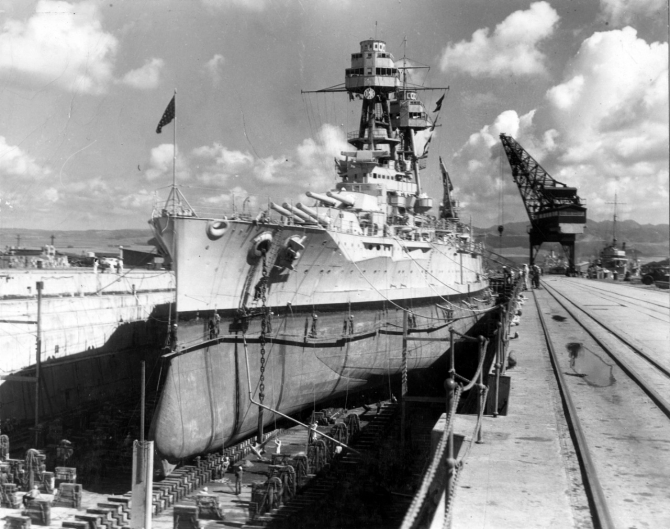
Nevada in Dry Dock No. 1 at the Pearl Harbor Navy Yard. Note the men painting her boot topping from stages rigged over the side, and the outline of her anti-torpedo blister where it merges with her forward hull. (Naval History and Heritage Command Photograph NH 50102)
Nevada weighed anchor and got underway bound for Hawaiian waters on 15 March 1938. Reaching on 31 March, she spent the next month engaged in Fleet Problem XIX (9 March–30 April). She would depart the Hawaiian area on 21 April and after a time operating off southern California, returned to San Pedro on the 30th. For a short time, 14-18 May, she left San Pedro for a visit to Santa Barbara and then returned home. Now assigned, with Arizona and Pennsylvania, to Battleship Division One (BatDiv1), Nevada and her counterparts each received three Curtiss SOC Seagull aircraft. The nine planes of these three ships in BatDiv1 constituted observation squadron VO-1B. Nevada got underway again on 1 July and spent much of the summer and fall conducting training in the California waters north of San Pedro. Returning on 1 November, she did not leave her homeport again in 1938.
Nevada got underway on 18 January 1939 and headed north for her regular maintenance availability at the Puget Sound Navy Yard. Entering the yard on 22 January, she underwent overhaul until 20 April, when she departed bound for San Francisco. Reaching on 24 April, she left that same day and, after operating several days off San Pedro, dropped anchor at her homeport on the 29th. Through May and early June, she cruised along the West Coast. On 17 June, however, she weighed anchor at Seattle and set a course westward, bound for the Hawaiian Territory. Arriving at Hilo on 24 June, she shifted to Lahaina Roads on the 27th, and Honolulu on 1 July. After four days, she departed on 5 July. After touching at San Diego on 11 July, she returned to San Pedro that same day. On 14 July she set a course north for visits to San Francisco, Seattle, and Bellingham, Wash. Departing the latter on 31 July, Nevada returned to San Pedro on 4 August, and remained in port into 1940.
Nevada got underway on 27 January 1940 for San Francisco and returned on 1 February. She did not get underway again until 2 April, when she weighed anchor and headed for Hawaii to again participate in the annual fleet problem. The last executed, Fleet Problem XXI took place from 1 April through 17 May. Arriving at Lahaina Roads on 10 April, Nevada operated in Hawaiian waters through the end of the exercise. Departing Lahaina on 17 May, she returned to the West Coast. She continued to operate off the West Coast and in Hawaiian waters through the year. On 25 October she steamed from Pearl Harbor and arrived at San Pedro on the 31st. After several weeks, Nevada got underway to return to the Puget Sound Navy Yard for her regular maintenance period. Entering the yard on 25 November, she underwent repairs for the next three months.
Leaving the Puget Sound Navy Yard on 25 February 1941, she set a course for Long Beach, Calif., where she arrived on 2 March. That same day, Nevada’s Seagulls were replaced by Vought OS2U-3 Kingfisher aircraft. After a period in port, Nevada got underway on 18 March bound for her new homeport at Pearl Harbor. As tensions with Japan continued to increase, she spent much of her time in the following months conducting training in the waters between Hawaii and the West Coast. One of her aircraft, on 24 September 1941, landed and a swell caught the left wing tip causing the plane to roll. A crash boat towed the aircraft to the ship, where it was hoisted aboard. Though damaged by the saltwater, the ship’s crew quickly restored it to working order and she was able to serve after hostilities with Japan broke out in December.
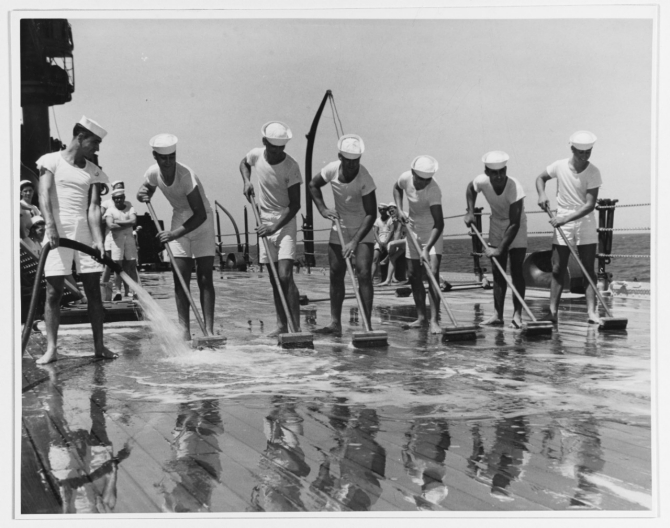
The seven Patten brothers man the brooms for clean-up detail, circa September 1941. From left to right: Bruce, Ray, Allen, Myrne, Clarence, Jr., Marvin, and Gilbert. (Naval History and Heritage Command Photograph NH 51886)
On 7 December 1941, Nevada was moored singly off Ford Island, and thus had freedom of maneuver denied the other six battleships along “Battleship Row” during the Japanese surprise attack. The enemy air attack was first observed around 0801 and general quarters sounded immediately. At 0802, machine guns opened fire on enemy torpedo planes approaching on the port beam. One plane was brought down by machine gun fire, but another dropped a torpedo which struck Nevada on the port bow. Around 0803, the ship’s 5-inch antiaircraft battery opened fire on Japanese aircraft making their bombing and strafing runs. At this same time, it was reported that the port 5-inch battery scored a direct hit on a torpedo bomber. As her gunners opened fire, her engineers got up steam and the ship got underway by 0840. The Japanese attack slackened at 0820, only to intensify at 0830, when a heavy bombing attack ensued. The antiaircraft batteries responded and fired continuously until 0908, when the attack subsided. At 0915, the 5-inch antiaircraft batteries opened an intermittent fire on Japanese planes to the eastward though they made no direct attack on the battleship. While engaging the multiple aircraft, Nevada made her way down the channel to escape the harbor and break out into open water. Given the damage to the ship, however, and fearing she might be sunk in the harbor’s entrance, effectively bottling up the fleet, it was decided to ground her in the shallows off Hospital Point. In the attack, Nevada suffered 50 crewmembers killed and 109 wounded. The ship sustained at least six, and possibly, as many as ten bomb hits and one torpedo hit on the port side about frame 42. While the damage to Nevada was considerable, the grounding of the ship ensured that she could be repaired and returned to action.
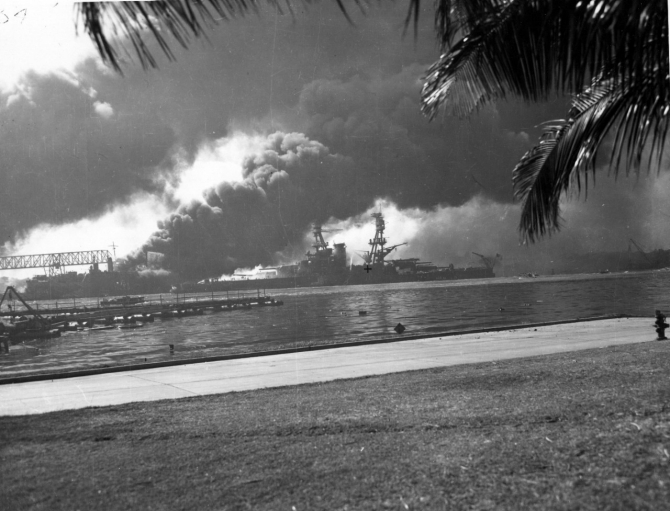
Nevada afire off the Ford Island seaplane base, with her bow pointed up-channel. Shaw (DD-373) burning in the floating dry dock YFD-2 is in the left background. Photographed from Ford Island, with a dredging line at left. (U.S. Navy Photograph 80-G-32457 National Archives and Records Administration, Still Pictures Division, College Park, Md.)
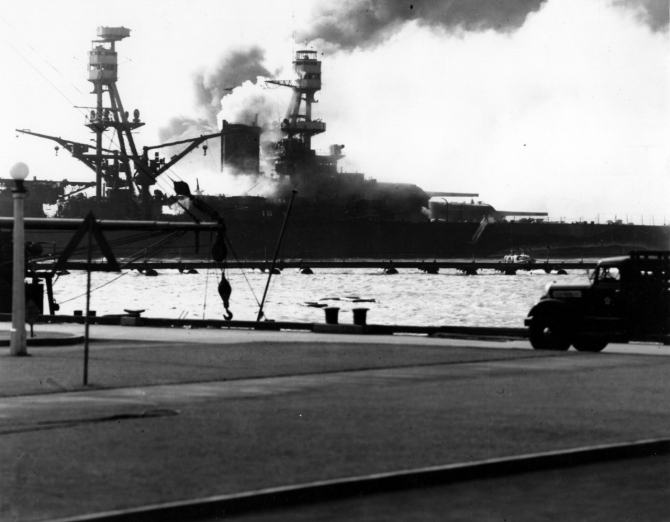
Nevada heading down the channel, afire from several Japanese bomb hits, as seen from Ford Island during the latter part of the attack. Ship whose boom and flagstaff are visible at left is Avocet (AVP-4). Note camouflage Measure 5 false bow wave painted on Nevada. (U.S. Navy Photograph 80-G-32443 National Archives and Records Administration, Still Pictures Division, College Park, Md.)
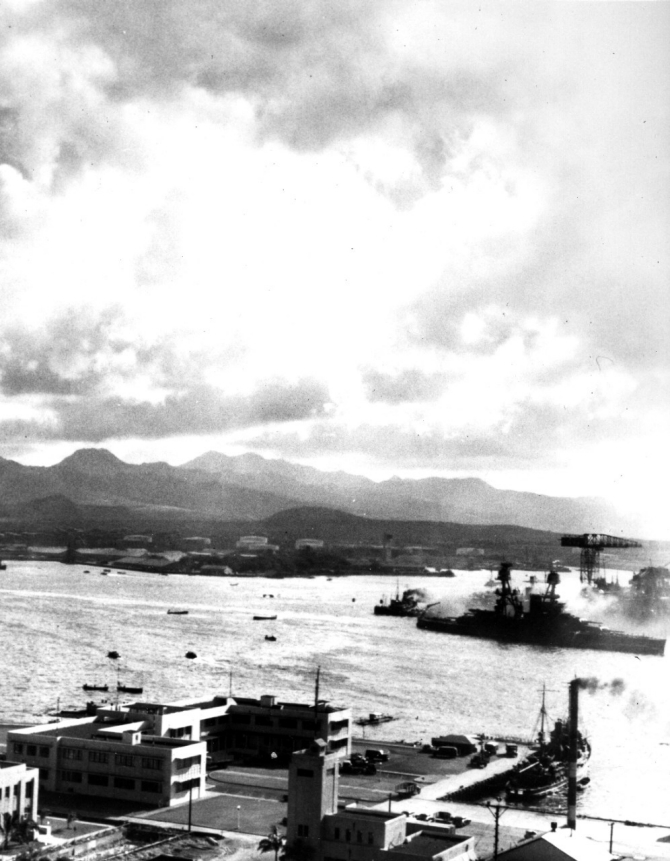
Nevada heading down the channel past the Navy Yard's 1010 Dock, under Japanese air attack during her sortie from Battleship Row. The camouflage Measure 5 false bow wave is faintly visible painted on the battleship's forward hull. Photographed from Ford Island. The smaller ship in the lower right is the tender Avocet (AVP-4). Note fuel tank farm in the left center distance, beyond the Submarine Base. (Naval History and Heritage Command Photograph NH 97397)
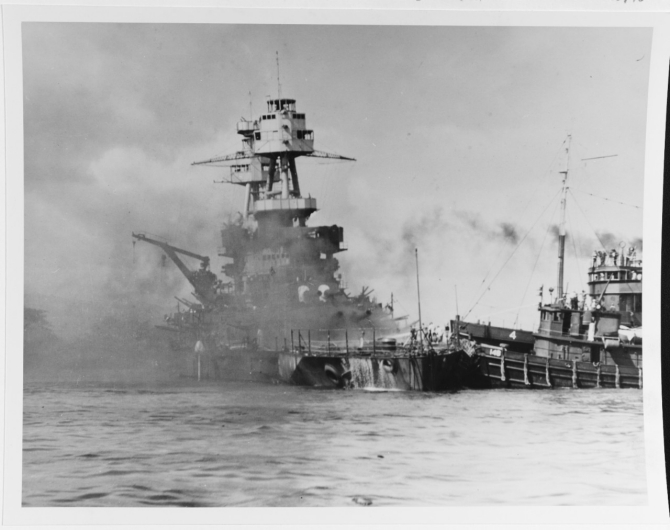
Nevada aground and burning off Waipio Point, after the end of the Japanese air raid. Ships assisting her, at right, are the harbor tug Hoga (YT-146) and the tender Avocet (AVP-4). (U.S. Navy Photograph 80-G-33020 National Archives and Records Administration, Still Pictures Division, College Park, Md.)
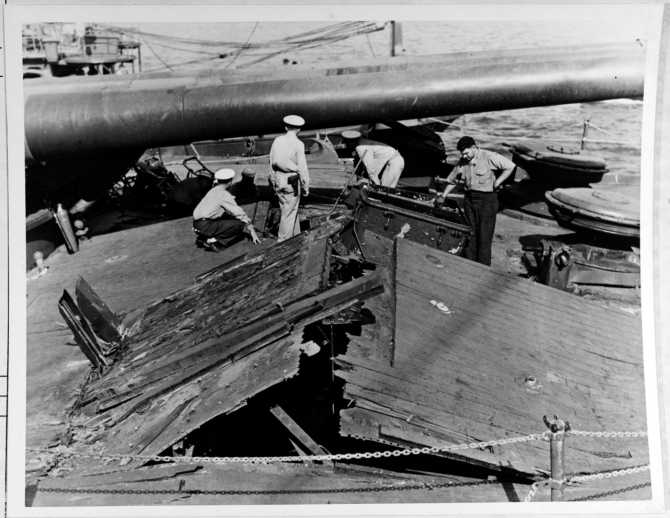
Damage to the forecastle deck of Nevada, caused by the explosion of a Japanese bomb below decks. Gun barrels of the battleship's forward 14/45 triple turret are in the background. Photographed on 12 December 1941 from on board Rail (AM-26), which was tied up alongside Nevada's starboard bow, assisting with salvage efforts. Note officer in center, wearing a .45 caliber pistol. (Naval History and Heritage Command Photograph NH 64484)
Refloated on 12 February 1942, Nevada was prepared for docking at Pearl Harbor on 17 February and she entered Dry Dock No. 2 the following day.
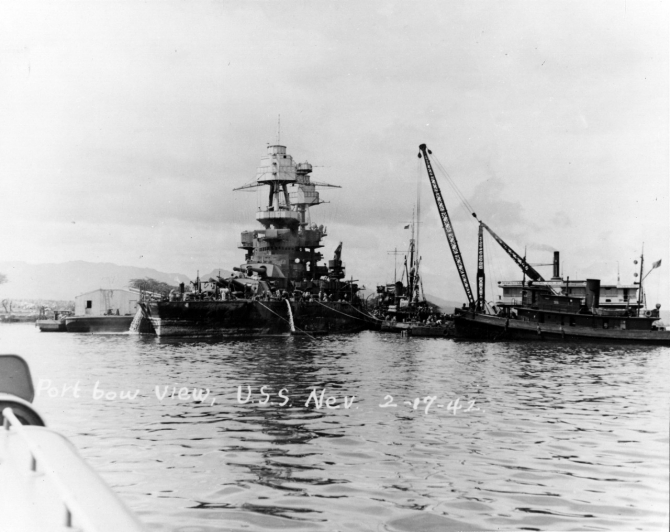
The Hawaiian Dredging Company crane barge Gaylord and other ships assist Nevada as she is prepared for drydocking at the Pearl Harbor Navy Yard, 17 February 1942. Collection of Vice Adm. Homer N. Wallin. (Naval History and Heritage Command Photograph NH 50106)
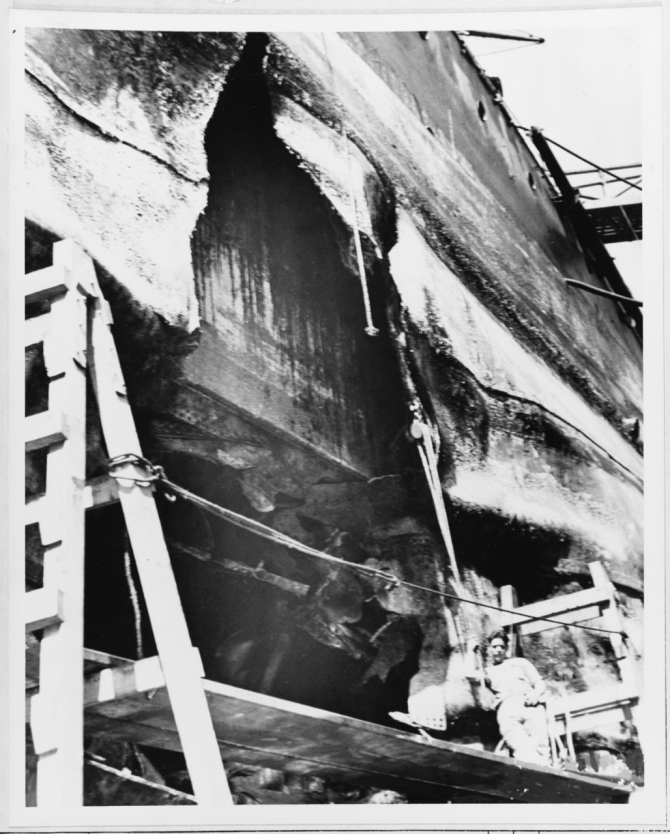
Hole in the ship's port side, between about Frame 38 and Frame 46, caused by a Japanese Type 91 aerial torpedo that hit her during the 7 December 1941 air raid. Photographed about 19 February 1942. The battleship's side armor is visible inside the hole's upper section. (Naval History and Heritage Command Photograph NH 64306)
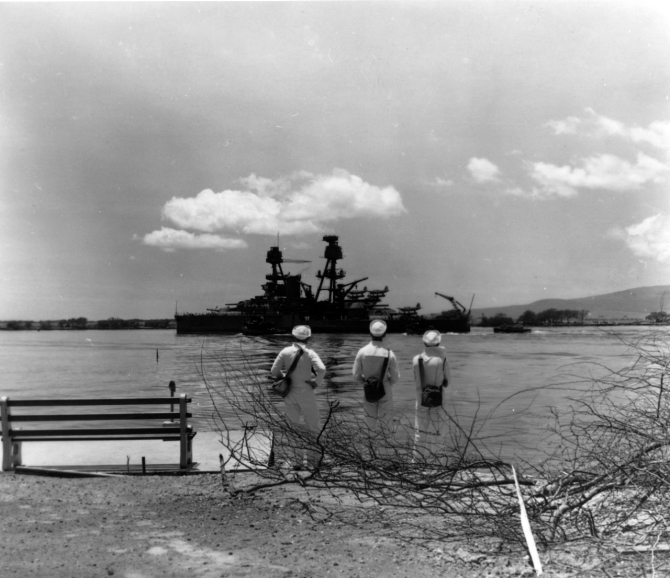
Nevada departing Pearl Harbor after temporary repair of bomb and torpedo damage received during the Japanese air raid on 7 December 1941. Photograph is dated 19 April 1942, possibly taken as the ship was leaving for a trial run. Note sailors watching, each carrying a gas mask container. Photographed by Photographer’s Mate 2nd Class H.S. Fawcett. (U.S. Navy Photograph 80-G-64768 National Archives and Records Administration, Still Pictures Division, College Park, Md.)
The Pearl Harbor Navy Yard completed work on Nevada on 22 April 1942. Afterward, she steamed to the Puget Sound Navy Yard for permanent repairs and modernization. Arriving at Bremerton on 1 May, she underwent an extensive rehabilitation and repair program that continued for seven and a half months at a cost of $23 million. She arrived back at San Pedro on Christmas Day.
Nevada departed San Pedro on 7 April 1943 and then sailed, bound for Alaska, on 23 April 1943. She was part of Task Force (TF) 51, the Assault Force under Rear Adm. Francis W. Rockwell for Operation Landcrab, the recapture of the island of Attu. Nevada, along with Pennsylvania and Idaho (BB-42), were to provide naval gunfire support (NGFS) to the landing units from the U.S. Army 7th Division. The battleships were joined by the escort carrier, Nassau (CVE-16), providing close air support (CAS). With destroyers and additional support ships, these units constituted the Support Group, Task Group (TG) 51.1. The task force rendezvoused at Cold Bay on 30 April. TG 51.1 departed on 4 May, steamed along the south side of the Aleutians, and entered the Bering Sea via Amutka Pass to avoid detection. Foul weather caused the postponing of the landings.
Nevada, accompanied by nine destroyers and three transports, opened fire with her main batteries on 11 May 1943, and rendered the Japanese positions at the head of Massacre Bay, Attu, ineffective. Meanwhile, Pennsylvania and Idaho neutralized enemy positions on the west arm of Holtz Bay. Nevada’s bombardment continued on the 12th and on the 13th, she fired four bombardments in support of infantry attacks that were cancelled. Despite the ships firing their allotted ammunition in support of the landings, much of the fire proved ineffectual due to the terrain and the quality of the Japanese fortifications. In any event, the Japanese were finally subdued after a failed banzai charge with heavy losses and a mass suicide on 29 May, and the island was secured by the next day.
In June 1943, Nevada returned to San Francisco for a short maintenance period at Mare Island Navy Yard, Vallejo, Calif., and then proceeded south to Panama. After transiting the Panama Canal, she sailed for further modernization at the Norfolk Navy Yard in preparation for service in the Atlantic Ocean and to support amphibious landings in the European Theater of Operations. After her time in the yard, she shifted to Boston and for several months, she engaged in convoy duty calling at New York, Maine, Massachusetts, and Ireland. On 18 April 1944, Nevada sailed from Casco Bay, Maine, bound for British waters in order to prepare for Operation Neptune, the landing component of Operation Overlord, the invasion of Normandy.
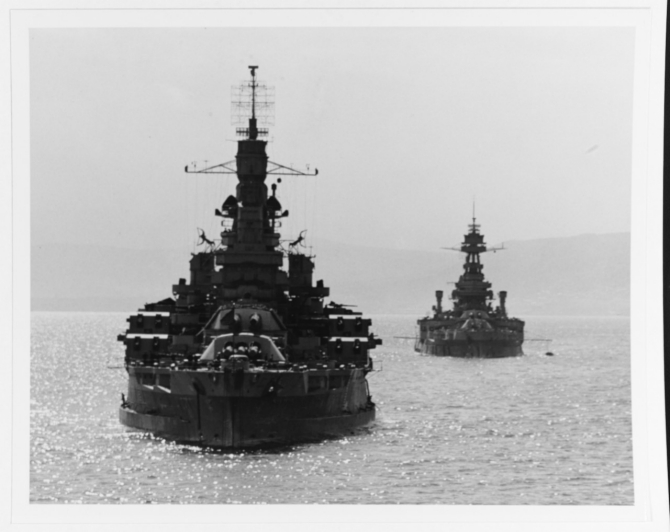
Photographed from Quincy (CA-71), Nevada in Belfast Lough, Northern Ireland, 14 May 1944. Texas (BB-35) is at right. (U.S. Navy Photograph 80-G-367897 National Archives and Records Administration, Still Pictures Division, College Park, Md.)
Nevada deployed as a component of Task Force (TF) 125’s Bombardment Group under Rear Adm. Morton L. Deyo in support of the Allied landings on Utah Beach. The other ships in the force included the heavy cruisers Tuscaloosa (CA-37) and Quincy (CA-71), the British heavy cruiser Hawkins (D.86), light cruisers Enterprise (D.52) and Black Prince (D.81), the monitor Erebus (I.02), and the Dutch gunboat Soemba. These ships maneuvered between the transports and the German batteries ashore. Maj. Gen. J. Lawton Collins, USA, commander of the U.S. VII Corps, especially requested main battery firing by Nevada and Quincy in support of his corps.
Initiating fires at 0536 on 6 June 1944, in advance of the landings, the task force continued for 50 minutes after H-hour. They targeted the heavy German batteries north of the beachhead using the air spotting techniques pioneered earlier in the year at Salerno, Italy. Nevada’s designated target was a German gun emplacement at Azeville, just north of the Utah landing site. After the bombardment of her initial targets, the battleship engaged German emplacements near St. Vaast-la-Hogue and then gave close support to the U.S. 101st Airborne Division units fighting to take Ste. Mere-Eglise and the causeways connecting the beaches to the main Allied axis of advance into Cherbourg. These firings were gratefully acknowledged by Maj. Gen. Matthew B. Ridgway, commander of the 82nd Airborne Division. Nevada, on 7 June, shelled fourteen different targets including 43 14-inch rounds fired to break up a German concentration north of the U.S. 4th Infantry Division. The next day, she fired at five casemated batteries and strongpoints between 0557 and 0940. She followed at 1023 with a firing of 70 14-inch rounds on a concentration of an estimated 110 German tanks and other vehicles at a range of 23,500 yards. Her spotting aircraft reported that all vehicles were either destroyed or damaged. Afterward, she retired to Plymouth, England, for replenishment, having fired 926 14-inch and 3491 5-inch rounds in support of the invasion. She subsequently returned to the gunline to continue providing NGFS until she retired on 17 June.
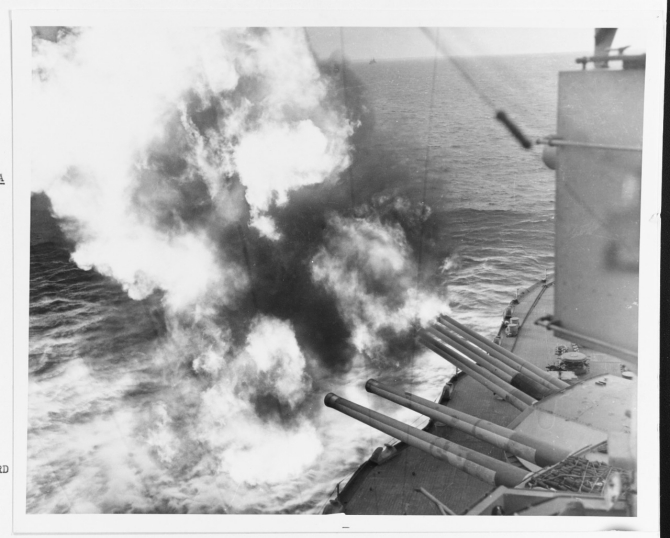
Forward 14/45 guns of Nevada fire on positions ashore, during the landings on Utah Beach, 6 June 1944. (U.S. Navy Photograph 80-G-252412 National Archives and Records Administration, Still Pictures Division, College Park, Md.)
Nevada, on 22 June 1944, rendezvoused with Rear Adm. Deyo’s Task Force (TF) 129 Cherbourg Bombardment force assembling at Portland, England. At 0430 on 25 June, she departed Portland, as a component of Group One, in company with Tuscaloosa, Quincy, Enterprise, the light cruiser Glasgow (C.21), and a screening force of five destroyers. This group was complemented by Group Two with Texas (BB-35) and Arkansas (BB-33) and a five destroyer screen. Nevada and her group moved into Fire Support Area 1, about 28,000 yards north of Cherbourg, at 1030. The group then closed to 12,000 yards at noon. As the ships awaited the advancing U.S. Army units’ calls for fire, the German batteries ashore opened fire at 1206. The accurate German fire scored a number of hits on Nevada’s companions and the battleship was bracketed by a three-gun salvo, one of whose shells landed within 100 yards. While Rear Adm. Deyo ordered the commencement of counter-battery fire, the German guns bracketed Nevada six times between 1240 and 1245. Capt. Powell M. Rhea, however, maneuvered the ship and successfully avoided being hit. With some of the task force ships sustaining hits, the accompanying destroyers laid smoke. Despite these conditions, Group One bombarded and eventually silenced the battery at Querqueville.
Contemporaneous with this action, the group commander received calls for fire from fire control parties ashore. At 1212, Nevada fired her 14-inch battery on a target approximately 2.5 miles southwest of Querqueville. The fire control parties spotted the incoming rounds and called in corrections. At 1229, rounds began hitting the target. In the following five minutes, Nevada delivered 18 14-inch rounds and, after 25 minutes of sustained bombardment, the Germans displayed a white panel by 1237. Using a spotting aircraft, she shifted to a new target between Querqueville and La Rivière and then onto a third. Responding to additional calls for fire by the fire control parties, Nevada continued to engage targets of opportunity until ceasing fire at 1525. In total, she had fired 112 14-inch and 985 5-inch rounds throughout the entire action and, despite being straddled in excess of 20 times, Nevada sustained no casualties and only superficial damage from shell fragments. After the action at Cherbourg, the vaunted battlewagon earned the moniker “Old Imperishable” and with the Allied armies advancing into the French interior, Nevada withdrew to Londonderry, Northern Ireland for a period of rest and replenishment.
On 4 July 1944, she steamed for the Mediterranean Sea. Having passed through the Straits of Gibraltar, Nevada reached Oran, Algeria, where her crew learned that she would participate in Operation Dragoon, the invasion of southern France. In this operation, Nevada joined with Texas, the light cruiser Philadelphia (CL-41); the French light cruisers Montcalm and Georges Leygues, large destroyers Le Fantasque, Le Terrible, and Le Malin; and seven destroyers in the Task Force (TF) 85 Gunfire Support Group, Rear Adm. Carleton F. Bryant commanding. This group supported the Delta landing sites in the vicinity of the Golfe de St. Tropez.
The initial landings began on 15 August 1944 and faced little resistance in the first few days. The situation changed on 19 August, when Nevada, the French battleship Lorraine, and the heavy cruiser Augusta (CA-31) conducted a reconnaissance in force off Toulon in order to support the U.S. Army's Third Division and French troops making a drive on that port. Escorted by four destroyers, Nevada, Lorraine, and Augusta shelled the harbor and batteries of 13.4-inch guns taken from French battleships scuttled early in the war at St. Mandrier; the heavy cruiser Quincy (CA-71) provided counter-battery fire on Giens, from a position south of Isle Port Cros. Nevada also engaged the German-manned French battleship Strasbourg, hitting her aft and causing her to list to starboard. As a destroyer deployed to screen her with smoke, Nevada continued firing and hit all the fortified gun emplacements even as her spotter plane was downed by German fire. With the smoke dissipating, Nevada withdrew. Returning the next day, Nevada re-engaged the repaired German guns at Cape Sicie and put them out of action. On 24 August, Nevada received orders to proceed toward Marseilles in order to engage the shore batteries on the islands of d’If, Pomeques, and Ratonneau that were harassing U.S. supply ships entering the recently-liberated Marseilles. After having to make corrections to compensate for her worn gun barrels, Nevada destroyed three batteries, put a fourth out of action and partially disabled a fifth. Lastly, she destroyed an enemy turret placed on a cliff top overlooking the harbor entrance. With this final successful fire mission, Nevada received orders to withdraw from her NGFS mission and proceed to Norfolk, via Algiers, for refit in preparation for deployment to the Pacific. While en route, she received orders diverting her to New York on 13 September. The ship arrived the next day, and after a short visit, the battleship departed for Norfolk on 17 September, arriving the next day.
Nevada’s gun barrels were relined at the Norfolk Navy Yard and the ship overhauled. Upon completion, she conducted trials (6-7 November 1944) and then steamed for the Panama Canal and the Pacific on 21 November. On 10 December, she arrived at Long Beach and spent the weeks afterward engaged in extensive gunnery and communications drills and taking ammunition and supplies on board. Spending Christmas 1944 at anchor at Long Beach, Nevada departed for the western Pacific on 28 December with Task Group (TG) 52.11. They rendezvoused with the fleet at Ulithi, Caroline Islands on 23 January 1945.
Rear Adm. Bertram J. Rodgers embarked and broke his flag in Nevada as Commander, Gunfire and Covering Force (TF 54) on 27 January 1945. Nevada then departed Ulithi as a unit of Task Group (TG) 54.9.2 in company with Idaho, Tennessee (BB-43), the heavy cruisers Chester (CA-27) and Pensacola (CA-24), and ten escorts on 10 February. Two days later, 12 February, the task group arrived off Tinian to participate in the rehearsals for the assault on Iwo Jima, Bonin Islands. With rehearsals completed, TF 54, now consisting of Estes (AGC-12), Nevada, five additional battleships, Idaho, Tennessee, Texas, Arkansas, and New York (BB-34), four heavy cruisers, a light cruiser, and escorts, departed from the rehearsal area in accordance with the movement order and proceeding along the prescribed route, arrived off Iwo Jima at 0600 on 16 February 1945. At 0707, Nevada fired the first salvo against the Japanese defenders. While an initial bombardment of the island had begun, the weather limited its value and fire was largely intermittent. With better weather on 17 February (D-Day minus 2), the barrage of Iwo Jima began in earnest. At 0700, the bombardment ships were in position and by 0911, Nevada, joined by Tennessee and Idaho, was 3,000 yards off the beach and firing at her designated targets. Late in the day, a line of gunboats supporting the swimmers preparing for the assault came under heavy fire. Being close inshore, Nevada fired upon the offending battery ashore for two hours and silenced it.
On D-Day, 19 February 1945, Nevada, along with California (BB-44), was charged with providing NGFS for the 5th Marines’ assault on Iwo Jima. Around 0925, as Nevada fired her assigned rolling barrage, the spotters observed that the rounds from the ship’s secondary battery did not penetrate a concrete blockhouse. In response, the ship redesignated the assignment to the 14-inch main battery. The resulting bombardment exposed an undisclosed blockhouse behind Red Beach 1 by removing the sand obscuring it. At 1100, when the blockhouse was again observed returning fire, Nevada fired armor-piercing shells which demolished the target. Later, at 1512, she observed a gun firing from a cave east of the landing beaches. Levelling her 14-inchers for direct fire, Nevada discharged two rounds. The resulting hit at the cave’s mouth blew out the side of the cliff and destroyed the enemy gun. As at Cherbourg, though straddled on several occasions, she did not receive any hits. During the ensuing night, the Japanese troops on the island mounted a counterattack to link up with forces on Mount Suribachi. In support of those ashore, Nevada fired star shells throughout the night and forced the Japanese to seek cover and concealment, thus breaking up the counterattack. The destroyer Terry (DD-513) took fire from a Japanese 6-inch battery and sustained a hit while passing Kitano Point around 0720 on 1 March. Nevada and Pensacola responded in kind and silenced the gun around 0730. The battleship remained on station off Iwo Jima providing NGFS until 7 March, when she was withdrawn at 1800. She departed in company with Task Group (TG) 52.29.12 and proceeded to Ulithi, arriving on 10 March, to prepare for Operation Iceberg, the assault on Okinawa in the Ryukyu Islands.
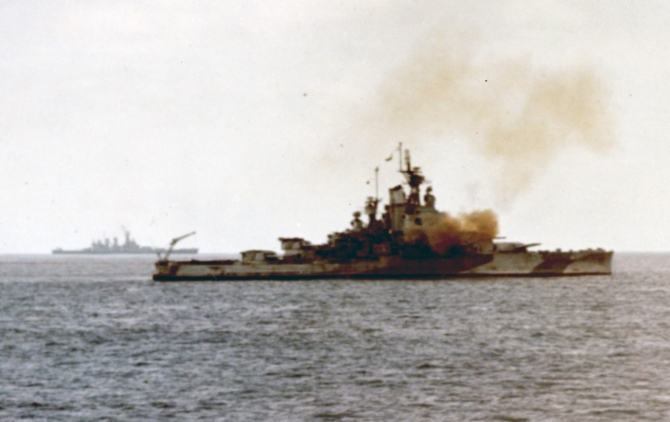
Nevada bombarding Iwo Jima, 19 February 1945. This image is cropped from Photo 80-G-K-3510 to emphasize Nevada's camouflage pattern. (U.S. Navy Photograph 80-G-K-3510 National Archives and Records Administration, Still Pictures Division, College Park, Md.)
On 21 March 1945, TF 54, the Gunfire and Covering Force under Rear Adm. Deyo, departed the anchorage at Ulithi and proceeded toward Okinawa. Unit Three, consisting of Nevada, Tennessee, the heavy cruiser Wichita (CA-45), the light cruisers Birmingham (CL-62) and St. Louis (CL-49), and five destroyers massed off the island on 24 March and initiated the pre-invasion bombardment. On 27 March, an Aichi D3A Type 99 carrier bomber (Val) crashed the ship killing 11 and wounding 49 members of the crew. The kamikaze attack also damaged Turret III along with three 20 millimeter mounts and two of the ship’s Kingfishers. On D-Day, 1 April, Nevada’s bombardment position was off Hagushi Beach on the island’s western shore.
Charged with providing NGFS for the “Old Breed” of the 1st Marine Division, she began firing at 0540 and shelled Japanese airfields, shore defenses, supply dumps, and troop concentrations throughout the operation. On 5 April 1945, another 2 men were killed and 17 wounded, when the ship took five rounds from a 6-inch battery ashore around 1740. Nevada replied with her 14-inch guns and silenced the enemy battery after 71 rounds. Despite this damage and the ever-present threat of massed kamikaze strikes, she remained on station off Okinawa. On 14 April, she received orders to return to rear areas with a recommendation for special availability. The next day, 15 April, she departed for Pearl Harbor via Guam.
Reaching Pearl Harbor on 2 May 1945, Nevada underwent overhaul and repair. She also received additional antiaircraft armament in preparation for the expected invasion of the Japanese home islands. With her yard work completed, the battleship underwent two days of trials and antiaircraft drills before departing for the bypassed Japanese garrison on the island of Emidji in the Jaluit atoll. Arriving off the island early on 18 June, Nevada, accompanied by the destroyers Murray (DD-576) and Taylor (DD-468), maneuvered to a range of 9,000 yards and began to bombard the island. With the silencing of the Japanese counterbattery fire in short order, Nevada closed to 4,000 yards and methodically raked the island, destroying her designated targets in progression. She then withdrew with her escorts and proceeded to Okinawa where she returned to the gunline in order to provide NGFS.
Nevada joined California and West Virginia (BB-48) on 30 June 1945 for operations in the East China Sea. The battleships, as part of Task Force (TF) 32, were to provide cover for minesweeping operations preparatory to the invasion of Japan. On 6 July, a squadron of enemy Mitsubishi Ki-46 Type 100 command reconnaissance planes (Dinah) approached the task force, but they were driven off by Navy fighters. Nevada later received orders, on 22 July, to detach from TF 32 and proceed north to join Task Force (TF) 95 for an attack by naval aircraft on a Japanese naval base near Shanghai, China. The battleship was subsequently joined by the large cruisers Guam (CB-2) and Alaska (CB-1), as both requested aid from the medical staff on board Nevada on 28 July, and then she returned to Buckner Bay, Okinawa, for replenishment on 31 July. She then sortied with the large cruisers for a return to operations in the East China Sea until they were relieved and ordered to Leyte Gulf, Philippines, on 7 August. She slipped her berth the next day and departed Buckner Bay, to be replaced by Pennsylvania which was hit by a Japanese aerial torpedo within a few hours of her arrival. On 15 August, within days of her reaching Samar, Leyte Gulf, Nevada’s crew received word that the Japanese had surrendered. World War II was over.
Nevada received orders to return to Buckner Bay and she remained there as the Japanese signed the articles of surrender on board Missouri in Tokyo Bay on 2 September 1945. Nevada departed for her homeport of San Pedro via Pearl Harbor on 23 September 1945. She subsequently received orders to report to Commander, Service Force Pacific Fleet (ComServPac) for Magic Carpet duty, conducting voyages to return troops home from the war on 9 October. Those orders, however, were changed on 20 October, when Nevada was assigned to the Pacific Fleet pending disposal. Her status then changed again on 14 November, when she was to be retained in an inactive status for experimental tests. In preparation for Operation Crossroads, the Bikini atomic experiments, Nevada received orders on 1 January 1946 to report to the Commander, Eleventh Naval District for stripping in preparation for that evolution. Afterward, she received orders to proceed to Pearl Harbor, reaching her destination in March.
Nevada arrived at Bikini atoll on 31 May 1946 and was one of 84 targets used in Crossroads. The tests consisted of two detonations, the first Test Able, an air burst, on 1 July, and the second, Test Baker, an underwater explosion, on 25 July. Despite extensive damage and contamination, the ship survived the blasts and returned to Pearl Harbor to be decommissioned on 29 August. She was sunk by the cumulative damage of surface gunfire, aerial bombs and torpedoes, and rocket fire off Hawaii on 31 July 1948. Nevada was stricken from the Navy Register on 12 August 1948.
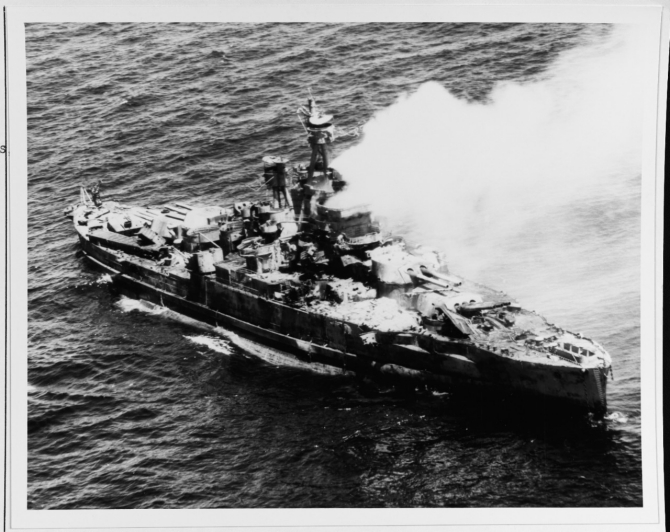
Nevada being sunk in ordnance tests off Pearl Harbor on 31 July 1948. (U.S. Navy Photograph 80-G-498257 National Archives and Records Administration, Still Pictures Division, College Park, Md.)
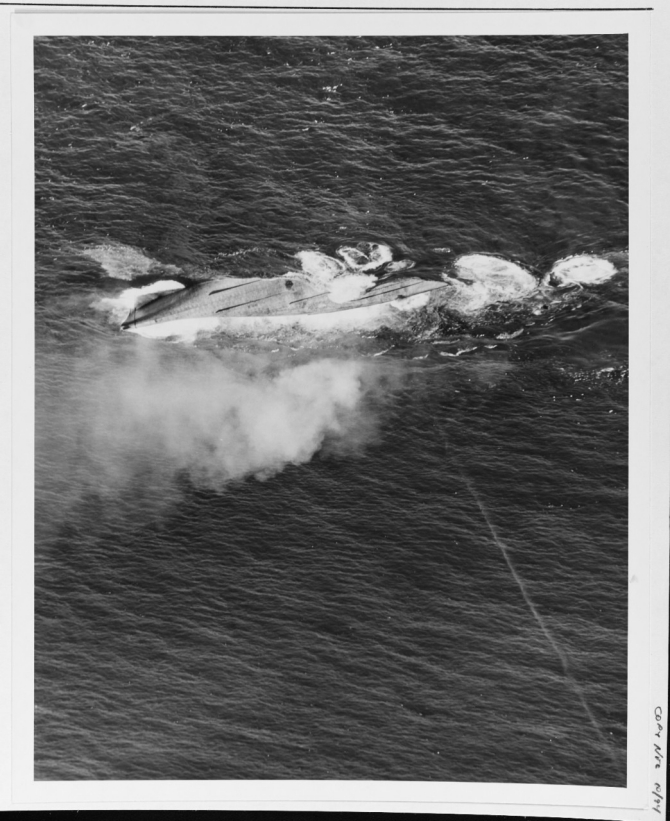
Nevada is sunk as a target off Hawaii on 31 July 1948. (U.S. Navy Photograph 80-G-498282 National Archives and Records Administration, Still Pictures Division, College Park, Md.)
Nevada received seven battle stars for her World War II service.
| Commanding Officers | Period of Command |
| Capt. William S. Sims | 11 March 1916 – 30 December 1916 |
| Capt. Joseph Strauss | 30 December 1916 – 14 February 1918 |
| Capt. Andrew T. Long | 14 February 1918 – 14 October 1918 |
| Capt. William C. Cole | 14 October 1918 – 7 May 1919 |
| Capt. Thomas P. Magruder | 8 May 1919 – 23 October 1919 |
| Capt. William D. MacDougall | 23 October 1919 – 4 May 1920 |
| Capt. Luke McNamee | 4 May 1920 – 19 September 1921 |
| Capt. Douglas E. Dismukes | 11 October 1921 – 30 December 1922 |
| Capt. John M. Luby | 30 December 1922 – 7 September 1924 |
| Capt. David W. Todd | 7 September 1924 – 11 June 1926 |
| Capt. Clarence S. Kempff | 11 June 1926 – 20 September 1927 |
| Capt. Hilary H. Royall | 14 January 1928 – 12 July 1930 |
| Capt. John J. Hyland | 12 July 1930 – 30 April 1932 |
| Capt. William S. Pye | 30 April 1932 – 4 December 1933 |
| Capt. Adolphus Staton | 4 December 1933 – 25 June 1935 |
| Capt. Robert L. Ghormley | 25 June 1935 – 23 June 1936 |
| Capt. Claude B. Mayo | 23 June 1936 – 2 October 1937 |
| Capt. Robert A. Theobald | 2 October 1937 – 10 May 1939 |
| Capt. Francis W. Rockwell | 10 May 1939 – 4 June 1941 |
| Capt. Francis W. Scanland | 4 June 1941 – 15 December 1941 |
| Capt. Henry L. Thompson | 15 December 1941 – 25 August 1942 |
| Capt. Howard F. Kingman | 25 August 1942 – 25 January 1943 |
| Capt. Willard A. Kitts, III | 25 January 1943 – 21 July 1943 |
| Capt. Powell M. Rhea | 21 July 1943 – 4 October 1944 |
| Capt. Homer L. Grosskopf | 4 October 1944 – 28 October 1945 |
| Capt. Cecil C. Adell | 28 October 1945 – 1 July 1946 |
Christopher B. Havern Sr.
12 December 2016


